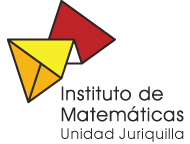Sesión especial del Seminario Preguntón
Institución: Comenius University, Bratislava / UNAM Juriquilla
| Cuándo |
19/11/2014 de 11:30 a 19:00 |
|---|---|
| Dónde | CINNMA (Casa Amarilla), Juriquilla, Querétaro |
| Agregar evento al calendario |
|
**********************************************************************************************************************************
Generalized palindromic closures
Palindromic closure of a finite word w is the shortest palindrome having w as a prefix. For ins- tance, Tribonacci word
u = 0102010010201010200..., that is defined as a fixed point of the substitution h(0) = 01, h(1) = 02, h(2) = 0, can be
constructed using directive periodic sequence ∆ = (012)^ω by repeated applications of the operation palindromic
closure and successive additions of letters from ∆. If we replace reflection by other involutory antimorphism θ, we can
talk about θ-palindromes and θ-palindromic closures.
In our presentation, we first summarize known results for infinite words that are created by palindromic closures using
one fixed antimorphism. Then we look at the situation where words are created using a pair of sequences: a sequence
of letters ∆ = (δ_n) and a sequence of antimorphisms Θ = (θ_n). We study infinite words that are results of θ-palindro-
mic closures, where for θ we successively take elements of Θ. We show that the Thue-Morse word, as well as its ge-
neralization for multi letter alphabet, can be obtained by the above construction. Similar result for other classes of
words were recently obtained by Blondin Massé et al.
The language of all words that are created by generalized palindromic closures is invariant with respect to group G
generated by antimorphisms that are appearing in Θ infinitely many times. Therefore, among these words we can find
new examples of G-rich words.
This is a joint work with Edita Pelantová and Štepán Starosta.
**********************************************************************************************************************************
16:00 Luis Montejano
UNAM Juriquilla
What is the maximum positive integer n such that every set of n points in R^d has the property that the convex hulls
of all k-set have a transversal d-lambda-plane? In this paper, we investigate this and closely related questions. We
define a special Kneser hypergraph by using some topological results and the well-known lambda Helly property. We
relate our question with the chromatic number of the Kneser hypergraph and we establish a connection lambda =1
with the so called Kneser. This problem is connected with the Gale embeddings, the discrete version of Rado’s
Problem, and with cyclic polytopes.
**********************************************************************************************************************************
17:00 Martin Skoviera
Comenius University, Bratislava, Eslovaquia
Snarks - recent development
Snarks are nontrivial cubic graphs whose edges cannot be properly coloured with three colours. Since their first
occurrence in the 19th century, these graphs have been an object of continuous interest especially because of their
relationship to various important problems in graph theory, such as the four colour problem, Tutteís 5-flow conjecture,
the cycle double cover conjecture, and Fulkersonís conjecture. In spite of great research efforts, their structure and
properties remain largely unknown. Our talk will survey recent development in this area by discussing various
properties of snarks, in particular those related to their composite structure, perfect matchings, flows, edge-
colourings, symmetries, embeddings, and others.
**********************************************************************************************************************************
18:00 Brindis
**********************************************************************************************************************************
Más información: https://sites.google.com/site/seminariopregunton/home

